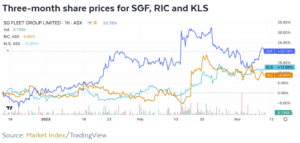By Glenn Freeman, Livewire
READ
Value will dominate Growth for at least the next couple of years, say Simon Conn and Mathan Somasundaram.
Like panicked passengers on a stricken ship’s life raft, investors crowding one sector then another tilts the market – often alarmingly so.
It’s been happening more frequently in recent years – especially towards the small cap part of the market, and particularly before rates started lifting last May. That’s according to Investors Mutual’s Simon Conn, who points to the building materials, online retailing, and tech sectors as prominent examples.
“People tend to chase one thing after another. And when everyone moves from one side to the other, it creates distortion where you get some stocks oversold and others over-bought,” says Conn, a small- and mid-cap senior portfolio manager at IML.
“For example, we saw many good Quality stocks being oversold coming into the half-yearly reporting season.”
Conn notes that the propensity for what he regards as “highly irrational, short-term investor behaviour” led to equally strange share price reactions. He explains this as an overhang of excessive short-termism – which has also seen a lot of money going into long-short funds and hedge funds due to misguided efforts to be more active.
“Even results that were just in line with expectations saw stocks rising 30% in some cases – and here we are in supposedly efficient markets,” Conn says.
Mathan Somasundaram, founder of research-driven model portfolio firm Deep Data Analytics, notes that Value stocks tend to be more prevalent in Australia than in the US, which is predominantly Growth. That’s because of our economic slant toward materials and financials.
What does that mean for investors? “When you have interest rates going up, the risk-return in the US is much more negative than in Australia,” Somasundaram says.
“In this interest rate environment, the local market was betting on a rate cut at some point this year. That’s not the case now – which the market will accept over time,” he says.
Somasundaram expects rates will continue rising for another six months, if not longer, and hold at that level until mid, or even late, next year.
“I don’t think the pivot’s any time soon. History also tells you it takes much longer,” he says.
“I suspect the recent bounce in Growth stocks – which happens multiple times through bear market rallies – are misplaced. I think Value will continue to outperform.”
But at the same time, Somasundaram believes investors can’t only pick Value stocks, “because when you have an economic slowdown, they can become value traps.”
For this reason, he emphasises investors need to be careful to buy Value stocks that still grow better than the market – and that the market will reward a “growth at a reasonable price” approach rather than pure value.
“Because as earnings get cut, the market will jump from one sector to another, so volatility is still going to be a big thematic over the next 12 months.”
Don’t fixate on sectors
Conn emphasises it’s not about favouring one or more sectors over another, instead preferring to think more holistically about the market.
“You can find cheap stocks in the healthcare and technology sectors – and expensive stocks in food retailing and other parts of retail because they’ve performed well and get bid up to some very full prices,” Conn says.
Conn believes the inefficiency of the small and mid-cap market is currently at extreme levels. Three company examples from the reporting season just ended, where in-line results drove strong share price rallies, include:
SG Fleet (ASX: SGF) – a provider of vehicle fleet management, leasing and automotive financing services
Ridley Corporation (ASX: RIC) – a stock feed and animal feed supplements company
Kelsian Group (ASX: KLS) – a provider of marine and land transport and tourism services

On the other side of the coin, many companies benefited from the more prevalent short-term thinking from investors, especially during the last few years. He points to the performance of physical store retailers versus online retailers such as Temple & Webster (ASX: TPW), Kogan (ASX: KGN), and Adore Beauty (ASX: ABY). They saw share prices gain, in response to the short-term effects of increased online activity and higher sales revenue, while the likes of Myer (ASX: MYR) and Harvey Norman (ASX: HVN) initially suffered in response to lockdowns and other COVID mitigation measures.
“But now things are normalising,” he says, pointing to Myer’s record first-half result handed down on Thursday.
What is Value?
Winding back slightly, Conn also discusses the broader Value style and its definition. Explaining it as the process of investing in good quality companies with predictable earnings that represent good value, Value investing is perhaps better understood by thinking about what it is not.
“There’s a misnomer that it’s about buying anything that looks cheap. And clearly, some businesses may appear cheap but they might have a broken franchise, a poor management team or a stretched balance sheet that creates the perception they’re cheap when they’re really not,” Conn says.
And when asked which sectors are typically considered Value versus Growth, he responds that it’s often about finding what’s in favour versus out of favour with the market.
“You might say some Healthcare stocks are considered growth because they’ve performed well over time and multiples are bid up quite high – such as Fisher and Paykel Healthcare (ASX: FPH) or Cochlear (ASX: COH),” he says.
“And you might say retailing and building materials companies are more Value because they’re cylical and you tend to buy them when they’re out of favour, and they trade up when the cycle turns.”
But overall, there’s (unfortunately) no shorthand way of determining Value versus Growth plays. Conn falls back on Warren Buffett’s adage about buying a dollar for 50 cents.
“It’s about identifying assets that are mispriced by the market. If you can do that – the market can be highly irrational in the short term and that creates opportunity,” he says.
No rigid definitions
Similarly, even companies that can be neatly packaged up as either Growth or Value at one point in time can shift into the alternate category.
“Share prices are man-made creations. There’s no rule to say a stock must trade on a certain multiple and has to keep delivering that growth,” Conn says.
On the Growth side, he believes some fund managers become “lazy” and instead stray into Momentum investing territory.
“But for a Value investor, Nirvana is buying a stock that looks cheap, delivers an outcome and then re-rates – perhaps into the scope of a Growth manager – and then the PE multiple expands. That’s a great way to make money as a value investor.
The problems for a Growth manager come when stocks do the reverse, becoming overbought by investors and then de-rating – often resulting in extreme capital losses.
Some local examples of stocks that have moved from Value into Growth territory are found within the healthcare and technology sectors. A couple of names Conn calls out are Cochlear and Resmed.
“They didn’t always trade on high 30s-type PEs as they do now. Going back 20 years, Cochlear (ASX: COH) and Resmed (ASX: RMD) traded at PE multiples of less than 20 times but have now re-rated significantly.”
Turnaround stories
The above view on stocks defying long-term definitions of either Growth or Value is shared by Somasundaram of Deep Data Analytics. He points to shareholder register services provider Computershare (ASX: CPU) as a classic example of an Australian Value company that has been priced like a Growth stock.
“It’s a defensive play, benefiting from higher yield and should be priced that way. But it’s now priced so that the multiple is like a Growth stock,” he says.
“The consensus for CPU in 2022 was 30 times PE, but in 2023 it i expected to drop to 15, with a long-term average of 14.”
Somasundaram also sees similar examples of this in the mining services sector, including ServiceStream (ASX: SSM) and Codan (ASX: CDA).
“They’ve been beaten up and are lower-growth turnaround stories. They used to be high multiple stocks but they’ve now become Value stocks,” says Somasundaram.
“I think the market will continue to move away from high growth stocks and towards the turnaround, value stocks that used to be growth stocks. That’s because you still want to buy Value that has a slight beat on the market growth.”
Conn’s three Value picks
Pathology services providers Australian Clinical Labs (ASX: ACL) and Sonic Healthcare (ASX: SHL) each hold top three market share positions in the local field. ACL has been owned by IML since it first listed, operating largely fixed-cost businesses, with revenue lines growing steadily in line with Australia’s ageing population.
“That steady growth in the mid-single digits can generate healthy EBIT and profit growth through time and these businesses generate good cash. And acquisitions and new product lines could generate more growth going forward,” Conn says.
Conn also calls out the national contracting services the company now has the ability to win. Since its acquisition of Medlab, it now has a national footprint and can bid for and potentially win large Australia-wide contracts, giving it further potential for growth.
In the recent half-year results, ACL management indicated the company is growing faster than the market. Alongside Sonic, it also used the boost from COVID testing to reduce costs and returned its margins to appropriate levels.
“It’s also cheap. We bought a lot more before the result, when it was priced in the low $3, it’s now trading in about $3.60 today and on a multiple of about 16.5 times,” Conn says.
“With a 4% fully-franked dividend and very little debt, we think it’s a good business for the next five years.”
Auto, 4WD parts provider
Automotive parts and four-wheel drive accessories retailer GUD Holdings (ASX: GUD) is another company Conn likes, having demonstrated in recent years its ability to grow and generate good margins – as demonstrated by competitor ARB (ASX: ARB).
GUD’s sensible acquisitions in this area in recent years have grown its presence in this market – despite a share price selloff after the purchase of AutoPacific Group in late 2021.
“They also had to downgrade earnings more recently when it had to reduce imports into Australia because of the semiconductor issues out of the Russia-Ukraine war and constrained supply chains,” Conn said.
But he believes the half-year result vindicated the acquisition, with the business showing good growth and an improving outlook.
“The stock was trading on a PE of less than 10 times going into the result but is now on about 13 times. The outlook is positive and the stock has rerated from below $8 to $10 in the space of a month.
GUD’s PE multiple of 13 times is, in Conn’s view, still cheap and the long-term thesis for the company is still in play.
While the information contained in this article has been prepared with all reasonable care, Investors Mutual Limited (IML) (AFSL No. 229988) accepts no responsibility or liability for any errors, omissions or misstatements however caused. This information is general in nature and does not constitute personal advice. This advice has been prepared without taking account of your personal objectives, financial situation or needs. Investors should be aware that past performance is not a reliable indicator of future performance. The fact that a particular security may have been mentioned should not be interpreted as a recommendation to buy, sell or hold that stock. Any reference to a particular security is general in nature and should not be taken as an endorsement by IML. Any forecasts referred to in this article constitute estimates which have been calculated by IML’s investment team based on IML’s investment processes and research.
INVESTMENT INSIGHTS & PERFORMANCE UPDATES
Subscribe to receive IML’s regular performance updates, invitations to webinars as well as regular insights from IML’s investment team, featured in the Natixis Investment Managers Expert Collective newsletter.
IML marketing in Australia is distributed by Natixis Investment Managers, a related entity. Your subscriber details are being collected by Natixis Investment Managers Australia, on behalf of IML. Please refer to our Privacy Policy. Natixis Investment Managers Australia Pty Limited (ABN 60 088 786 289) (AFSL No. 246830) is authorised to provide financial services to wholesale clients and to provide only general financial product advice to retail clients.










